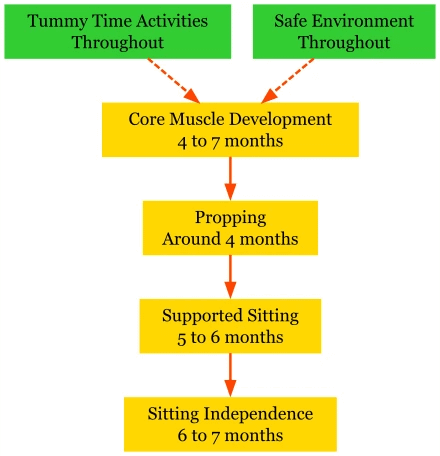Babies can typically sit in a shopping cart when they have achieved good head control, can sit with minimal support, and show an interest in their surroundings. This milestone often occurs around six to eight months of age, but it varies from baby to baby. Always ensure that the shopping cart is clean, secure, and equipped with safety straps before allowing your baby to sit in it for a shopping trip.

Shopping with a baby can be both a delightful and challenging experience for parents. One of the common questions that arise is, “When can babies sit in a shopping cart?” This seemingly simple query is rooted in understanding the developmental milestones of a baby, especially when it comes to sitting.
As babies grow, they achieve various milestones that signify their physical and cognitive development. Sitting independently is one such significant milestone that not only indicates their physical progress but also their readiness to interact more with the world around them.
This article delves into the intricacies of a baby’s sitting development, the importance of proper posture, signs that indicate readiness for a shopping cart, and safety guidelines to ensure a comfortable and secure experience for your little one during shopping trips.
Whether you’re a new parent or a seasoned one, this comprehensive guide will equip you with the knowledge to make informed decisions about your baby’s transition from the car seat to the shopping cart.
Key Takeaways:
- Babies can typically sit in a shopping cart when they have achieved good head control, can sit with minimal support, and show an interest in their surroundings, usually around six to eight months of age.
- Prioritize cleanliness, cart stability, and safety straps when choosing a shopping cart for your baby.
- Alternatives to using a shopping cart for younger babies include baby carriers, slings, strollers with storage compartments, or bringing another caregiver.
- Ensure a safe and comfortable shopping cart experience by cleaning the cart, using safety straps, and never leaving your baby unattended.
- Transitioning from sitting in a car seat to sitting in a shopping cart should be done with consideration of your baby’s developmental readiness and close supervision to ensure their safety and comfort.
Understanding the Developmental Milestones of Sitting
| Developmental Milestones of Sitting | Age Range | Description |
|---|---|---|
| Propping | Around 3 months | Babies prop themselves up on their forearms while lying on their stomachs, strengthening neck muscles. |
| Supported Sitting | 4 to 6 months | Babies can sit with support from cushions or by using their hands placed behind them. |
| Independent Sitting | 6 to 8 months | Babies develop the ability to balance themselves while seated unsupported, gaining core muscle control. |
| Proper Posture | Ensuring proper baby sitting posture is crucial for healthy spine, muscle, and bone development. |
Babies go through various developmental milestones as they grow, and sitting is one of the significant ones. It marks a crucial stage in their physical development and opens up new opportunities for exploration and interaction with their surroundings. As parents or caregivers, it is essential to understand these milestones to ensure that babies are progressing appropriately. WebMD – Baby Development provides valuable insights into the developmental milestones of babies, including their journey towards sitting independently.
The first milestone in sitting development is called propping. At around three months old, babies can prop themselves up on their forearms while lying on their stomachs. This position helps strengthen their neck muscles and prepares them for future stages of sitting. The next milestone is supported sitting, which typically occurs between four to six months old. During this stage, babies can sit with support from cushions or by using their hands placed behind them.
Once babies have achieved supported sitting, they gradually progress towards independent sitting without assistance. Around six to eight months old, they start developing the ability to balance themselves while seated unsupported. Initially, they may rely on wider bases of support or use their arms for stability but eventually gain enough strength and control over their core muscles to sit upright independently.
Understanding these developmental milestones allows parents and caregivers to provide appropriate support and encouragement during each stage of a baby’s journey toward independent sitting. By creating a safe environment conducive to exploration and providing opportunities for practice, we can help our little ones develop strong muscles and achieve important motor skills necessary for further growth and development.
The Importance of Proper Baby Sitting Posture
Proper baby sitting posture is crucial for the healthy development of your little one. It not only supports their physical growth but also helps in building strong muscles and bones. When a baby sits with correct posture, it allows them to explore their surroundings, interact with objects, and develop important motor skills. According to the American Academy of Pediatrics (AAP), ensuring proper sitting posture is essential for healthy spine, muscle, and bone development.
One key aspect of proper sitting posture is maintaining a straight back. Encouraging your baby to sit up straight helps in strengthening their core muscles and improves their balance. Additionally, it aids in the development of good spinal alignment, which can prevent future issues such as poor posture or back pain.
Another important factor to consider is supporting your baby’s head and neck while they are sitting. Their neck muscles are still developing at this stage, so providing adequate support ensures that they maintain proper alignment and avoid straining those delicate muscles.
Furthermore, ensuring that your baby’s feet touch the ground or a supportive surface while sitting can contribute to better overall posture. This allows them to push off from their legs when trying to reach for objects or move around independently.
By prioritizing proper baby sitting posture, you are setting the foundation for healthy physical development and promoting optimal motor skills acquisition. Remember to always supervise your little one during these early stages of sitting development to ensure safety and comfort as they explore their environment.
The Early Stages of Sitting Development
| Early Stages of Sitting Development | Age Range | Description |
|---|---|---|
| Core Muscle Development | 4 to 7 months | Babies gradually build strength and coordination in core muscles, preparing for sitting independently. |
| Propping | Around 4 months | Babies start propping themselves up on their hands while lying on their stomachs. |
| Supported Sitting | 5 to 6 months | Babies can sit with support, often using pillows or cushions for stability. |
| Sitting Independence | 6 to 7 months | Babies gain control and can sit unsupported for longer durations, developing balance and stability. |
| Tummy Time Activities | Throughout | Encouraging tummy time strengthens neck and back muscles essential for independent sitting. |
| Safe Environment | Throughout | Providing a safe space with soft surfaces supports exploration and prevents injuries during practice. |

During the early stages of sitting development, babies go through a gradual process of building strength and coordination in their core muscles. This milestone typically occurs between 4 to 7 months of age, although it can vary from baby to baby. At first, babies may start by propping themselves up on their hands while lying on their stomachs. They then progress to being able to sit with support, such as using pillows or cushions around them for stability. The CDC – Child Development Milestones provides additional insights into these crucial developmental stages.
As babies continue to develop their sitting skills, they will gradually gain more control over their bodies and be able to sit unsupported for longer periods of time. It is important during this stage to provide a safe environment for your baby’s exploration and practice. Placing soft surfaces around them can help prevent injuries if they topple over or lose balance.
Parents should also encourage tummy time activities during this stage as it helps strengthen the neck and back muscles necessary for sitting independently. Engaging in interactive play while your baby is on his or her tummy can make this experience enjoyable and beneficial at the same time.
By understanding the early stages of sitting development, parents can better support their baby’s growth and provide opportunities for them to build strength in preparation for future milestones like crawling and walking. Remember that each child develops at their own pace, so be patient and celebrate every small achievement along the way!
Signs that Indicate Your Baby is Ready to Sit in a Shopping Cart
When it comes to determining if your baby is ready to sit in a shopping cart, there are several signs to look out for. Firstly, your baby should have good head control and be able to hold their head up without support. This is important as sitting upright in a shopping cart requires strength in the neck and upper body muscles.
Additionally, your baby should be able to sit with minimal or no assistance. They should have developed enough core strength to maintain a seated position without constantly toppling over. It’s also important that they can balance themselves and have some stability while sitting.
Another sign that indicates your baby is ready for the shopping cart is if they show an interest in their surroundings. If they are curious about what’s going on around them and seem eager to explore, it may be a good time to introduce them to sitting in a shopping cart.
Remember, every baby develops at their own pace, so it’s essential not to rush this milestone. Take into consideration these signs along with any specific guidelines recommended by pediatricians or healthcare professionals before allowing your little one to sit in a shopping cart.
Factors to Consider Before Allowing Your Baby to Sit in a Shopping Cart
| Factors to Consider | Description | Criteria |
|---|---|---|
| Developmental Readiness | Ensure baby has reached appropriate developmental milestones for sitting. | – Strong muscles – Coordination |
| Shopping Cart Size and Stability | Check for a sturdy, secure cart with no loose or broken parts. | – Cart stability – Absence of damage |
| Safety Belt/Harness | Verify if the cart has a safety belt or harness system for baby’s security. | – Presence of safety measures |
| Cart Cleanliness | Consider the cleanliness of the cart to avoid exposure to germs and bacteria. | – Use of disinfectant wipes or covers |
When considering whether to allow your baby to sit in a shopping cart, there are several factors that you should take into account. First and foremost, you need to ensure that your baby has reached the appropriate developmental milestones for sitting independently. It is important for their muscles and coordination to be strong enough to support themselves in an upright position. For a comprehensive guide on baby gear safety, don’t forget to check out our Baby Gear Safety Guide for expert insights and recommendations.
Another factor to consider is the size and stability of the shopping cart itself. Make sure that it is sturdy and secure, with no loose or broken parts. Additionally, check if it has a safety belt or harness system in place to keep your baby safely secured while sitting.
Furthermore, think about the cleanliness of the shopping cart before placing your baby inside. Shopping carts can harbor germs and bacteria from previous users, so consider using disinfectant wipes or covers to create a cleaner environment for your little one.
Overall, it’s crucial to prioritize your baby’s safety when deciding whether they are ready to sit in a shopping cart. Assess their developmental readiness, evaluate the condition of the cart itself, and take steps towards maintaining hygiene during this experience. By considering these factors carefully, you can make an informed decision regarding when and how best to introduce your baby into the world of shopping trips.
Alternatives to Using a Shopping Cart for Younger Babies
When it comes to shopping with younger babies who are not yet ready to sit in a shopping cart, there are several alternatives that can provide a safe and convenient option. One popular alternative is using a baby carrier or sling. These devices allow you to securely hold your baby close to your body while leaving your hands free for shopping. Baby carriers come in various styles and designs, such as wraps, slings, or structured carriers, so you can choose the one that best suits your needs and comfort. Check out our Baby Carrier and Sling Reviews for detailed insights into the top options available.
Another alternative is using a stroller with an attached basket or storage compartment. Many strollers have spacious baskets underneath the seat where you can place your groceries or other items while pushing your baby around the store. This option allows you to keep an eye on your little one while also having space for all of your purchases.
If neither of these options is feasible for you, consider bringing along another caregiver who can watch over the baby while you shop. This could be a partner, family member, or friend who can take turns accompanying you on grocery trips. Having someone dedicated solely to looking after the baby ensures their safety and allows you to focus on getting what you need without any worries.
By exploring these alternatives instead of relying solely on a shopping cart for younger babies, parents can find practical solutions that prioritize both convenience and safety during their shopping outings. Whether it’s using a baby carrier or sling, utilizing the storage space in a stroller, or enlisting help from another caregiver – there are plenty of options available for parents seeking alternatives when their little ones aren’t quite ready for sitting in a shopping cart yet.
Tips for Ensuring a Safe and Comfortable Shopping Cart Experience for Your Baby
When it comes to ensuring a safe and comfortable shopping cart experience for your baby, there are several important tips to keep in mind. First and foremost, always make sure that the shopping cart you are using is clean and free from any potential hazards. Wipe down the handlebar and seat area with disinfectant wipes before placing your baby in the cart.
Additionally, it is important to be mindful of weight distribution when placing items in the shopping cart. Avoid overloading one side of the cart as this can cause it to become unbalanced and potentially tip over. Distribute heavier items evenly throughout the cart, keeping them low and centered for added stability.
For additional tips on enhancing your baby’s shopping cart experience, explore our Baby Shopping Cart Covers for insights on creating a safe and comfortable environment.
Common Mistakes to Avoid when Allowing Your Baby to Sit in a Shopping Cart
When allowing your baby to sit in a shopping cart, it is important to avoid certain common mistakes that can compromise their safety. One mistake to avoid is placing your baby in the main basket of the cart without any additional support. This can be dangerous as they may not have enough stability or balance to sit upright on their own. Instead, use a specially designed infant seat or harness that attaches securely to the cart.
Another mistake to avoid is leaving your baby unattended in the shopping cart. Even if you are just grabbing an item from a nearby shelf, accidents can happen within seconds. Always keep one hand on the cart or use a safety strap provided by some stores to ensure your baby stays secure and protected.
Additionally, it is crucial to never overload the shopping cart with heavy items while your baby is sitting inside. The weight distribution can become imbalanced and cause the cart to tip over, potentially injuring both you and your child. Be mindful of how much weight you are adding and consider using alternative methods such as pushing a stroller alongside for heavier purchases.
By being aware of these common mistakes and taking necessary precautions when allowing your baby to sit in a shopping cart, you can ensure their safety and make each trip more enjoyable for both of you. Remember that proper support, constant supervision, and avoiding excessive weight are key factors in creating a safe environment for your little one during this stage of development. For more information on baby health and safety, you can also explore Mayo Clinic – Baby and Toddler Health.
Shopping Cart Safety Guidelines for Babies
When it comes to shopping cart safety for babies, there are a few guidelines that parents should follow. First and foremost, always ensure that your baby is securely strapped into the shopping cart seat. This will help prevent them from falling or sliding out of the seat while you’re navigating through the store. Additionally, make sure to use the provided safety straps correctly and adjust them according to your baby’s size.
Another important guideline is to never leave your baby unattended in the shopping cart. Even if you just need to grab an item from a nearby shelf or check something quickly, always bring your baby with you. It only takes a moment for an accident to occur, so it’s crucial to keep constant supervision on your little one.
Lastly, be mindful of where you place items in the shopping cart. Avoid putting heavy or bulky items near your baby as they could potentially fall onto them during transit. Instead, opt for placing these items underneath the cart or in designated areas meant for larger items.
By following these simple guidelines, parents can ensure their baby’s safety while using a shopping cart during their grocery trips or outings. Remember that vigilance and caution are key when it comes to protecting our little ones in any environment.
Transitioning from Sitting in a Car Seat to Sitting in a Shopping Cart

Transitioning from sitting in a car seat to sitting in a shopping cart is an important milestone for your baby. It signifies their growing independence and ability to engage with the world around them. However, this transition should be approached with caution and careful consideration of your baby’s developmental readiness.
Firstly, it is essential to ensure that your baby has developed sufficient head and neck control before allowing them to sit in a shopping cart. This milestone typically occurs around 4-6 months of age. Without proper head control, your baby may struggle to maintain an upright position in the cart, increasing the risk of injury.
Additionally, you should consider the size and stability of the shopping cart itself. Opt for carts that have secure straps or harnesses to keep your baby safely seated. Ensure that there are no sharp edges or loose parts that could pose a danger.
Lastly, always supervise your baby closely while they are sitting in a shopping cart. Keep one hand on them at all times to prevent any sudden movements or accidents. Remember, their balance may still be developing during this stage, so it’s crucial to provide support and guidance as needed.
By following these guidelines and considering your baby’s individual development level, you can ensure a safe and comfortable transition from sitting in a car seat to sitting in a shopping cart without compromising their well-being.
Frequently Asked Questions
Developmental Milestones of Sitting:
Q1: What are the developmental milestones of sitting?
A1: The developmental milestones of sitting include being able to hold the head steady, having good control of the neck muscles, being able to sit with support, and eventually being able to sit unassisted.
Proper Baby Sitting Posture:
Q2: Why is proper baby sitting posture important?
A2: Proper baby sitting posture is important for their spine and hip development, as well as to prevent any discomfort or pain. It also helps in promoting better balance and coordination.
Signs that Indicate Your Baby is Ready to Sit in a Shopping Cart:
Q3: How can I tell if my baby is ready to sit in a shopping cart?
A3: Look for signs such as your baby being able to sit up with little or no support, having good head and neck control, and showing interest in their surroundings. They should also be able to support their own weight with their legs.
Factors to Consider Before Allowing Your Baby to Sit in a Shopping Cart:
Q4: What factors should I consider before allowing my baby to sit in a shopping cart?
A4: Factors to consider include the age and development of your baby, their ability to sit independently, the size and stability of the shopping cart, and the presence of safety straps.
Alternatives to Using a Shopping Cart for Younger Babies:
Q5: Are there alternatives to using a shopping cart for younger babies?
A5: Yes, alternatives include using a baby carrier or sling, using a stroller with a detachable seat, or carrying your baby in your arms while shopping.
Tips for Ensuring a Safe and Comfortable Shopping Cart Experience:
Q6: How can I ensure a safe and comfortable shopping cart experience for my baby?
A6: Make sure the shopping cart is clean and free from hazards, use a cart cover or blanket for added comfort, secure your baby with the provided safety straps, and never leave your baby unattended.
Shopping Cart Safety Guidelines for Babies:
Q7: What are some common mistakes to avoid when allowing my baby to sit in a shopping cart?
A7: Avoid placing your baby in a shopping cart without proper support, overloading the cart with heavy items, or placing your baby in the front of the cart where they can reach potentially dangerous items.
Q8: What are some shopping cart safety guidelines for babies?
A8: Safety guidelines include always using the provided safety straps, avoiding carts with broken or loose parts, never placing a car seat on top of a shopping cart, and keeping a close eye on your baby at all times.
Transitioning from Car Seat to Shopping Cart:
Q9: How can I transition my baby from sitting in a car seat to sitting in a shopping cart?
A9: Start by gradually increasing the amount of time your baby spends in a seated position outside the car seat, practice sitting with support at home, and then gradually introduce sitting in a shopping cart for short periods of time.
[Check Out Our Article On Top 5 Infant Car Seats of 2023: Comprehensive Review & Guide]


